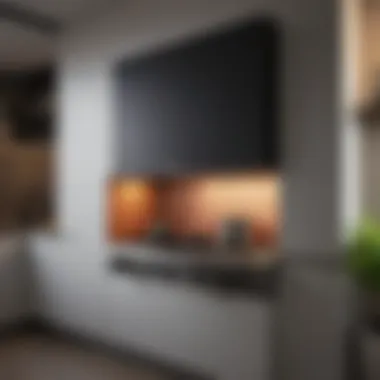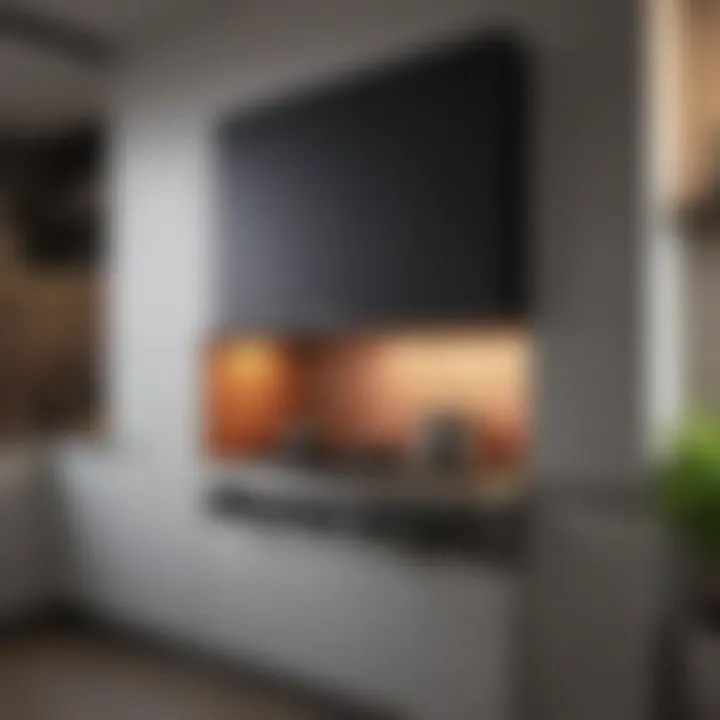Maximize Kitchen Storage Next to Your Stove


Intro
The kitchen is often described as the heart of the home. Yet, one area that often remains overlooked in terms of design and functionality is the space next to the stove. This area plays a crucial role in cooking efficiency and organization. Proper optimization ensures not only ease of access to essential utensils and ingredients but also promotes an aesthetically pleasing environment. In this article, we will explore various practical solutions that can enhance storage beside the stove, catering to homeowners, interior design enthusiasts, party hosts, and gardening aficionados.
Each section will provide insights into contemporary trends, thematic organization, and the interplay between functionality and design. From innovative shelving ideas to the integration of greenery, our aim is to transform a potentially cluttered zone into a streamlined, inviting space. Let’s delve into the multiple aspects of optimizing storage next to the stove.
Understanding Stove Proximity
The proximity of storage to the stove significantly influences both functionality and efficiency in the kitchen. When cooking, having easy access to necessary items can greatly enhance the overall experience. This aspect becomes even more vital when considering safety and practicality. Positioning storage appropriately can prevent unnecessary movements, keeping the focus where it is needed most—on the cooking.
The Importance of Accessible Storage
Having accessible storage means that items like oils, spices, and utensils are within arm's reach when cooking. This convenience not only saves time but also reduces the likelihood of accidents. For instance, reaching over hot pans can lead to burns or spills. Efficient storage solutions next to the stove minimize such risks while creating a place that lets homeowners work efficiently.
- Ease of Use: Items stored within proximity are much easier to grab. This allows for smoother meal preparation, especially in busy cooking moments.
- Safety First: Placing frequently used items near the stove allows cooks to stay focused without overreaching or turning away from hot surfaces.
- Cohesive Design: Accessible storage promotes a visual clarity that maintains the kitchen’s design integrity. Proper placement ensures that form does not come at the expense of function.
When designing a kitchen or reorganizing existing space, consider how often certain items are used. Place commonly used spices or cooking utensils close to the stove to establish a seamless workflow during food preparation.
Impact on Kitchen Workflow
The layout of a kitchen, especially in relation to the stove, has a profound effect on how tasks are executed. An efficient workflow minimizes time spent looking for tools or ingredients, leading to a more enjoyable cooking process.
Several factors contribute to the impact of storage proximity on kitchen workflow:
- Task Efficiency: Well-stocked and placed items streamline processes like chopping or sautéing. Cooks can multitask effectively when everything is organized around them.
- Minimized Steps: Ideally, storage solutions reduce the number of steps needed to retrieve items while cooking. Fewer steps translate directly into faster meal prep.
- Easier Cleanup: A kitchen that is organized around cooking needs helps in quickly returning items to their designated spots. This promotes a tidy cooking environment.
Ultimately, understanding the significance of stove proximity shapes how a kitchen operates. Focusing on accessible storage and efficient workflow can create an environment that is not only practical but also enhances the joy of cooking. Integrating these concepts leads to a well-functioning kitchen that suits the user's unique habits and preferences.
Material Considerations for Storage Solutions
When it comes to optimizing storage next to the stove, material considerations play a vital role. The kitchen is not just a space for cooking; it is also an area where materials need to withstand heat, moisture, and frequent use. Selecting the right materials is essential for ensuring both safety and durability in your storage solutions. This section will cover two primary aspects: heat resistance and safety, as well as the durability of the materials for long-term use.
Heat Resistance and Safety
One of the primary concerns when choosing storage solutions near the stove is the ability of materials to resist heat. Given the high temperatures generated by cooking, it’s essential to consider materials that can withstand such conditions without degrading.
For example, metal shelves can endure high temperatures and are often recommended for proximity to the stove. Stainless steel, in particular, is a popular choice due to its robustness and aesthetic appeal.
On the other hand, materials like wood or certain plastics may warp or become discolored over time if they are continuously exposed to heat. It’s important to avoid these materials in areas close to the stove, since safety is paramount. The risk of fire or accidents increases if heat-sensitive materials come into contact with hot surfaces.
In addition to being heat resistant, the materials should also be safe for food preparation. For storage solutions that might come into contact with food items, ensuring they are non-toxic and easy to clean is crucial.
"Opt for materials that combine heat resistance with safety for a kitchen space that is both functional and secure."
Durable Materials for Long-Term Use
Durability is another significant factor when considering storage solutions next to the stove. Choosing materials that promise longevity can save homeowners time and money in the long run. Materials like metal, tempered glass, and certain high-quality plastics can provide the necessary durability for a kitchen environment that faces constant usage.
Metal shelves, as mentioned, are not only heat-resistant but also durable against scratches and dents. They are an excellent investment for spaces near the stove where pots and pans may be frequently handled.
Similarly, tempered glass is a strong option. It resists chipping and can maintain its appearance over time, making it suitable for both shelving and cabinet doors. However, one should ensure that the installation is stable to prevent accidents.
Lastly, investing in good quality finishes for wood can keep them resilient against wear and exposure to moisture. Regular maintenance and proper sealing can enhance the longevity of wood materials, making them suitable for storage solutions around the cooking area.
Types of Storage Solutions
The area next to the stove is often the heart of kitchen activity. Choosing the right types of storage solutions is crucial for maintaining an efficient cooking environment. Effective storage not only improves accessibility but also contributes to overall kitchen organization and aesthetics. Whether you are a culinary enthusiast or an occasional cook, understanding these types can greatly impact your kitchen experience.
Open Shelving Systems
Open shelving systems are increasingly popular in modern kitchens. They provide easy access to cooking essentials and create a sense of openness. When utilized next to a stove, they can display spices, oils, and frequently used utensils.
*
- Promotes quick access to items while cooking.
- Offers a visually appealing way to organize space.
- Can be customized with decorative items to enhance kitchen aesthetics.
However, dust can accumulate on open shelves, which means regular cleaning is necessary. Additionally, open shelving may not be ideal for every kitchen layout, particularly in smaller spaces where clutter can form quickly.


Cabinets and Drawers
Cabinets and drawers near the stove allow for more discreet storage solutions. They are versatile and can be configured to fit various kitchen designs. Within cabinets, you can place pots, pans, and other cooking tools out of sight yet within reach.
*
- Ensure easy access when cooking.
- Incorporate pull-out drawers for pots and pans, which can save time and effort.
The advantage of cabinets and drawers is that they keep items organized and hidden from view, which contributes to a tidy appearance. The interior space can be maximized using dividers or organizers to keep like items together.
Rolling Carts
Rolling carts are a flexible storage solution that can adapt to various needs. They are particularly useful in smaller kitchens, where mobility becomes valuable. Positioned next to the stove, a rolling cart can serve multiple purposes, such as a prep station or extra storage for ingredients.
*
- Easily moved to create more space as needed.
- Can be outfitted with additional storage options like hooks or baskets.
The versatility of rolling carts makes them an attractive option for those who entertain frequently or have changing kitchen needs. Their portability can create opportunities for social cooking experiences and more efficient food preparation.
Magnetic Strips for Utensils
Magnetic strips offer a smart and innovative way to store utensils near the stove. They keep items like knives and metal tools conveniently at hand while freeing up counter space. Some major benefits are:
*
- Quick access to tools saves time during meal prep.
*
- Reduces clutter on counters, decreasing the risk of accidents.
The installation is simple, and they can fit into any kitchen style, whether modern or traditional. Additionally, magnetic strips can be mounted in seamless ways, adding to the overall organization.
Important Note: Proper placement of magnetic strips is critical to avoid interference with cooking surfaces or equipment.
In summary, each storage solution near the stove has its merits and drawbacks. Selecting the right combination can maximize both functionality and aesthetics in your kitchen.
Organization Techniques for Cooking Essentials
Efficient storage is essential in any kitchen, and organizing cooking essentials fosters a more functional workspace. The arrangement of items directly affects cooking efficiency and enjoyment. When items are well organized, they are easy to access during meal preparation, allowing cooks to focus on the task at hand rather than searching for needed utensils or ingredients. Beyond practicality, effective organization creates an inviting atmosphere in the kitchen, conveying a sense of order and tranquility. Coupling these improvements with aesthetics can elevate the overall kitchen experience.
Grouping Similar Items Together
Grouping similar items together is a method that streamlines both accessibility and workflow. Items that are frequently used together, like utensils, pots, and spices, should be stored in close proximity. For instance, placing spatulas and mixing bowls near the stove makes it convenient when preparing meals. This method eliminates unnecessary movements across the kitchen, reducing the risk of accidents and spills.
Consider using baskets or trays to keep these items organized. When similar items are arranged, it becomes straightforward to locate what is needed quickly. This organizational practice can also make it easier to see when supplies need replenishing.
Using Clear Containers for Visibility
Using clear containers can drastically enhance visibility and organization. When items are stored in transparent containers, it allows for easy identification of contents without the need to open each one. This becomes especially useful for pantry items or spices that can blend together in opaque packaging.
Labeling clear containers can also reinforce organization, confirming the content at a glance. Clear containers create an efficient method of storage, allowing cooks to maintain awareness of what they have on hand. This is particularly advantageous when cooking for groups or attempting to try new recipes, as it minimizes preparation time.
Vertical Storage Solutions
Vertical storage is a practical technique to maximize space, especially in smaller kitchens. Utilizing wall space or tall cabinets for storage can free up counter areas while keeping necessary items within arm's reach. Solutions such as shelves, hooks, and pegboards are excellent choices for vertical storage.
By utilizing vertical space, homeowners can display utensils or frequently used cookware, creating an aesthetically pleasing kitchen environment. This technique not only saves space but also adds character to the kitchen. As a recommendation, consider installing adjustable shelving to accommodate various item types and sizes, promoting flexibility in organization.
"An organized kitchen is the heart of a effective cooking experience."
In summary, effective organization techniques serve as foundational elements in optimizing storage next to the stove. These methods improve workflow, enhance visibility, and utilize space intelligently, leading to efficient and enjoyable cooking experiences. By implementing these strategies, you can ensure that your kitchen remains functional while reflecting your personal style.
Integrating Aesthetics with Function
In kitchen design, the balance between aesthetics and functionality is crucial. While a well-designed storage solution adds beauty to the space, it must also serve its purpose effectively. The area next to the stove is often a focal point where both elements should complement each other. Homeowners must consider not just the visual appeal but also how these choices can improve the cooking experience. This integration can streamline cooking tasks while enhancing the overall ambiance, making it more enjoyable to spend time in the kitchen.
Selecting Colors and Finishes


Choosing the right colors and finishes for storage next to the stove impacts both its aesthetic value and practicality. Light-colored finishes can create an impression of openness and cleanliness, while darker shades might convey warmth and coziness. For example, white or soft pastel shades can make small spaces appear larger, thus benefitting compact kitchens. Additionally, finishes should be easy to clean since the proximity to heat and cooking activities creates the need for hygiene.
Consider finishes like matte or semi-gloss. Each can suit different styles while offering various levels of durability against heat and grease stains. Always select a material that withstands exposure to warmth. Using color swatches in conjunction with kitchen lighting can help finalize the most pleasing combinations.
Personalizing with Decorative Storage
Decoration in functional spaces aids expression of style without compromising form. Decorative storage solutions provide an opportunity to exhibit personal taste. Consider using attractive canisters for spices or oils, or even stylish bowls for additional ingredients. These pieces can be both beautiful and practical, enriching the kitchen's aesthetics.
Adding decorative elements does not limit to color choices. Textures such as woven baskets or elegant boxes can bring an inviting feel while organizing tools or utensils. Furthermore, hanging racks or hooks with an artistic flair can enhance the space while keeping essential items easily within reach.
Thoughtfully curated decorative storage can elevate both organization and style. When storage is convenient and appealing, it encourages a more organized and efficient kitchen environment.
Effective integration of aesthetics and function enhances the overall cooking experience while maintaining an organized workspace.
Ultimately, the goal is to create a harmonious kitchen space that motivates productivity while being personally reflective of one's style.
Space-Saving Ideas for Small Kitchens
In modern living, maximizing every inch of space is crucial, especially in small kitchens. The area next to the stove often becomes cluttered and inefficient. Therefore, implementing thoughtful space-saving ideas is not only practical but essential. Utilizing innovative storage solutions can significantly enhance your cooking experience while ensuring that everything remains organized and easily accessible.
Narrow Cabinet Solutions
Narrow cabinets are a brilliant option for small kitchens. They fit into tight spaces and can be surprisingly functional. You can install them beside the stove, making the most of your kitchen layout. By leveraging vertical space, these cabinets create room for spices, oils, and cooking essentials. This ensures that needed items are within arm's reach without taking up much space.
Find cabinets that offer adjustable shelves. This way, you can customize storage according to your needs, accommodating taller bottles or smaller jars as necessary. Consider incorporating a pull-down rack inside the cabinet for efficient utilization of the vertical space.
Pull-Out Shelves
Pull-out shelves are another smart storage solution. They help keep items hidden yet easily accessible. Imagine having all your cooking essentials neatly arranged on shelves that slide out smoothly. This approach allows for better organization without overwhelming your countertop.
When selecting pull-out shelves, focus on material durability. Wood or metal can withstand heat and humidity well, which is relevant in kitchen environments. Additionally, consider adding dividers within these shelves to categorize spices, utensils, or pots, which can streamline preparation and cooking time.
Under-Counter Storage
Under-counter storage can transform unused spaces into valuable areas. Consider installing small cabinets or drawers that fit under countertops or kitchen islands. This space can house less frequently used items, keeping them out of sight.
It's important to choose storage solutions that are easily accessible. Pull-out drawers or bins can be efficient, allowing you to retrieve stored items without hassle. Ensure these storage pieces align with the overall kitchen aesthetic, as they should feel like a natural extension of your kitchen design.
Efficient storage can enhance cooking flow in tight spaces.
When you integrate these space-saving ideas into your small kitchen, you create a more efficient cooking environment. Focusing on narrow cabinets, pull-out shelves, and under-counter storage contributes significantly to fostering an organized, functional, and inviting kitchen atmosphere.
Adapting to Changing Kitchen Needs
In any kitchen, the only constant is change. As cooking habits, family sizes, and lifestyles evolve, so too do the requirements for efficient kitchen storage adjacent to the stove. Adapting to these changing needs is crucial for maintaining functionality and ease of access. This adaptability not only improves the overall workflow but also ensures that the kitchen remains a welcoming environment.
Flexible Storage Solutions
Incorporating flexible storage solutions allows homeowners to adjust their kitchen setup according to current requirements. Items such as adjustable shelving or multi-functional furniture can significantly enhance the usability of the space near the stove. For example, a rolling cart can serve as both a prep area and extra storage, making it easier to access items on the go.
Consider the following elements in flexible storage:
- Customizable Shelves: Adjustable shelving can accommodate taller pots and pans or be lowered for everyday essentials.
- Mobile Units: Carts and trays on wheels help in repositioning storage as needed, adapting to both cooking and entertaining scenarios.
- Hidden Compartment Storage: Incorporate cabinets that offer concealed storage, helping keep the area near the stove organized and clutter-free.
By blending style with practicality, flexible storage solutions cater to changing needs while maintaining aesthetic appeal.
Reassessing Storage Regularly
To keep the kitchen efficient, reassessing storage is an essential practice. Regular evaluations help identify what is being used, what is no longer needed, and how to maximize space efficiently. This involves periodically going through items, assessing their utility, and removing anything that contributes no value.
Factors to consider include:
- Usage Frequency: Items used daily should be easily accessible, while rarely used gadgets can be stored away.
- Seasonal Changes: Some items are seasonal, like holiday cookware, and can free up space during off-seasons.
- Shift in Preferences: Cooking styles may evolve, leading to different tools being prioritized; adjusting storage accordingly can help streamline tasks.
Regular reassessment of storage can enhance kitchen efficiency and ensure that peak workflows are maintained, helping to create a seamless cooking environment.
Overall, by adopting flexible solutions and committing to regular reassessment, homeowners can adapt their kitchens beside the stove to better meet their shifting needs. This ensures both functionality and a cohesive design that aligns with their evolving culinary life.


Maintenance for Long-Lasting Storage Systems
When it comes to optimizing storage next to the stove, maintenance is an essential factor. Keeping storage systems in good condition prolongs their usability and aesthetic appeal. Regular care ensures that everything from cabinet doors to open shelves functions effectively. Over time, wear and tear can happen, especially in high-traffic areas like the kitchen. Therefore, establishing a routine maintenance plan is beneficial.
Routine Cleaning Methods
Regular cleaning is vital for maintaining the functionality of storage systems. Here are some practical cleaning methods for stove-adjacent storage:
- Daily Wipe-down: After cooking, it's a good practice to quickly wipe down surfaces. This prevents grease and crumbs from accumulating, which can dull surfaces over time.
- Weekly Clean: Choose a day each week to perform a more thorough cleaning. This can include removing items from shelves, dusting, and disinfecting surfaces with suitable cleaners that are heat resistant.
- Monthly Checks: Take a look for signs of damage or wear monthly. This can involve checking for loose screws, stains, and any signs of pest activity.
Using materials like microfiber cloths helps avoid scratches, and ensuring that cleaning products are safe for the type of materials used in your kitchen remains crucial.
Importance of Regular Inspections
Routine inspections can uncover issues that may otherwise go unnoticed. These inspections should focus on both structural integrity and usability of your storage solutions.
- Identifying Wear: Checking for loose hinges, squeaky drawers, or cracks can help you address problems before they worsen. Often, small fixes can prevent larger, expensive repairs.
- Assessing Usability: Evaluate if the current layout still meets your needs. With changes in cooking habits or family size, the functionality of your storage can decline, warranting reorganization or replacement.
"Regular inspections not only maintain the aesthetic of your kitchen but also enhance the efficiency of your cooking space."
- Hotspot Checks: Proximity to the stove means exposure to heat and moisture. Inspect shelf materials to ensure they are not warped or damaged by steam or heat exposure.
Case Studies: Effective Kitchen Design
Case studies in kitchen design provide real-world examples that illustrate effective solutions for stove-adjacent storage challenges. These examples demonstrate how different configurations and designs can enhance functionality and efficiency in a critical kitchen area. By analyzing various layouts and solutions, homeowners can gain insight into what works and what does not when optimizing storage near the stove. These case studies highlight the importance of considering space constraints, user habits, and aesthetic preferences.
Key benefits of studying these designs include the ability to:
- Learn from successes: Each case study showcases practical applications, allowing readers to adapt successful elements to their setups.
- Gain insights into challenges: Understanding the obstacles faced by others offers valuable lessons on potential pitfalls to avoid.
- Inspire creativity: Seeing how others have tackled their kitchen design can inspire homeowners to rethink their own spaces, pushing the boundaries of conventional design.
When evaluating these case studies, it is crucial to consider factors such as layout, materials used, and the integration of various storage solutions. Readers are encouraged to assess their own kitchen needs and adapt concepts tailored to their specific situations.
Successful Small Kitchen Solutions
In small kitchens, maximizing space is paramount. Case studies reveal numerous clever design strategies tailored for compact environments. For instance, one effective solution is the use of vertical storage. By installing shelving above the stove, homeowners can keep essential cooking tools within reach without sacrificing counter space.
A prime example is the design of a city apartment kitchen that features a narrow, tall cabinet next to the stove. This cabinet incorporates pull-out shelves that provide easy access to pots and pans while keeping them tucked away and organized. The focus on height instead of width allows the homeowners to utilize every inch of space efficiently.
Common strategies observed in small kitchens include:
- Utilizing multi-functional furniture: Incorporating a rolling cart that serves as a prep space and storage for herbs and spices saves space and increases functionality.
- Implementing open shelving: Open shelves allow for easy access to cooking necessities and can create an illusion of space.
- Installing racks for pots and pans: Ceiling-mounted racks free up valuable storage area and keep frequently used pots and pans visible and accessible.
Large Kitchens with Seamless Flow
Larger kitchens benefit from their ability to accommodate various storage solutions without overwhelming the space. Case studies show that seamless flow is achieved through strategic planning. For example, a large kitchen layout might include cabinetry that integrates smoothly with countertops and the stove. This design creates a cohesive and inviting workflow.
An effective approach involves grouping storage solutions based on function. For instance, placing a spice rack directly beside the stove allows for immediate access while cooking. This arrangement is essential for maintaining an organized and efficient cooking environment.
Key considerations observed in larger kitchens include:
- Zoning: Different areas of the kitchen are designated for specific tasks such as cooking, prepping, and storage. This zoning contributes to a streamlined cooking experience.
- Storage depth variations: Incorporating both shallow and deep cabinets creates dynamic storage options that can accommodate a range of items.
- Incorporating decorative elements: A blend of utility and aesthetics, such as using glass-fronted cabinets for display, enhances the kitchen’s appeal while serving a practical purpose.
Understanding how to design your kitchen effectively can lead to not just a functional space, but a kitchen that inspires your culinary journey.
Through studying these effective kitchen designs, homeowners can identify solutions that resonate with their style and practicality needs. This guidance will ultimately assist in creating a kitchen that is not only organized and efficient but also a pleasure to use.
Concluding Thoughts on Stove Storage
Optimizing storage next to the stove is an essential aspect of kitchen design. This area is often pivotal for functionality, where efficiency meets aesthetics. Efficient stove storage can streamline cooking processes, reducing time spent searching for utensils or ingredients. With thoughtful arrangement, one can significantly enhance workspace usability while keeping everything aesthetically pleasing.
By focusing on the key elements discussed in this article, we encourage a well-planned approach to stove side storage. It is not merely about placing items close to the cooking space but ensuring that these items are organized, easily accessible, and safe.
Summarizing Key Points
In this article, we covered several crucial aspects of stove storage optimization:
- Accessible storage is integral for an efficient kitchen workflow. It provides quick access to cooking essentials, which minimizes interruptions while cooking.
- Material choices matter greatly. Heat-resistant and durable materials ensure safety and longevity, avoiding any risks that might arise from close proximity to heat sources.
- Different types of storage solutions are available, from open shelving to magnetic strips, catering to diverse kitchen layouts.
- Organizational techniques help maintain order, making it easy to find items and promote a clean environment.
- Integrating aesthetics with function enhances not only usability but also elevates the overall kitchen design.
- Space-saving ideas for small kitchens offer strategies that maximize every inch without sacrificing functionality.
- Flexibility in storage ensures that the kitchen can adapt to changing needs, allowing for a dynamic cooking environment.
Encouraging Thoughtful Arrangement
It is important to thoughtfully arrange storage near the stove. Items should be organized by frequency of use. Frequently used pots, pans, and utensils should be within arm's reach. Group similar items to create a natural flow that makes sense while you cook.
Consider using clear containers for visibility. This allows quick identification of ingredients, avoiding wasted time during meal preparation. Moreover, evaluate your storage solutions regularly. This practice helps to adjust as needs change, ensuring your kitchen remains efficient.
The goal is to create a space that feels organized and functional. Proper layout fosters a cooking environment that encourages creativity and efficiency. Good storage solutions contribute to a cooking experience that is not only efficient but also pleasant.



